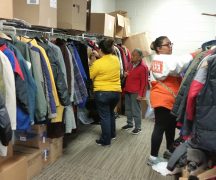On January 28, you published a report of a homeless man charged with criminal damaging for climbing through the window of an empty building. Comments on the Facebook version of the story primarily expressed sympathy for the man and wondered how our community can better help the homeless. I would like to amplify this question.
The need is clear. I’ve lived in this community for nearly 30 years, and I don’t recall seeing people pushing shopping carts down Main Street when I first moved here. I do now. A homeless man is frequently seen sitting outside McDonald’s; people buy him coffee. I see “scruffy-looking” individuals on the streets, and I’m not sure whether they’re making a personal hygiene choice (which is everybody’s right), or whether they have no opportunities to get a haircut, a shower, and a fresh change of clothes. These are anecdotal, personal observations; I would think that JFS or some other city or county agency may have a clearer statistical picture of the homelessness problem in Bowling Green. But it’s clear to anyone with open eyes that it is a problem.
I know very little about the regulations and practices of housing the homeless. But a quick search told me that there are no state-level regulations for homeless shelters in Ohio. (There are some regulations about reporting runaway teens, and making sure that any counseling is offered by licensed professionals.) A search for Wood-County specific regulations turned up only general building regulations.
This means that Bowling Green, if we have the will, is free to house the homeless in (almost) any way we choose. We have numerous buildings that could theoretically be used for this purpose. There are plenty of churches near the city center; I don’t think any of them have showers, but several have kitchens certified for public use. If the community prefers not to have this be a “religious” endeavor, the Senior Center comes to mind, as does our new city building, which is usually empty overnight barring meetings.
What would it take? The buildings are there; a few donations of bedding (even sleeping bags and mats for a start), some volunteer staffing to welcome people and “keep order” (with police as a back-up), and publicizing the availability of the service. That’s it, as far as I can tell. Even such a minimal service—a roof, heat, and a sleeping space—is a starting point that could make a huge difference to the health of our local homeless.
In a small, welcoming town like Bowling Green, why aren’t we already doing this? Who is responsible; who will step up?
Kristie Foell
Bowling Green



